

For the open loop transfer function, G(s)H(s):
We have n=2 poles at s = 0,
-3. We have m=0 finite zeros. So there exists q=2 zeros as s goes to
infinity (q = n-m = 2-0 = 2).
We can rewrite the open loop transfer
function as G(s)H(s)=N(s)/D(s) where N(s) is the numerator polynomial, and D(s)
is the denominator polynomial.
N(s)= 1, and D(s)= s2 + 3 s.
Characteristic Equation is 1+KG(s)H(s)=0, or 1+KN(s)/D(s)=0,
or D(s)+KN(s) =
s2
+ 3 s+ K( 1 ) = 0
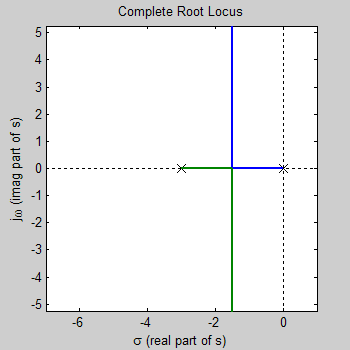
As you can see, the locus is symmetric about the real axis
The open loop transfer function, G(s)H(s), has 2 poles, therefore the locus
has 2 branches. Each branch is displayed in a different color.
Root locus starts (K=0) at poles of open loop transfer function, G(s)H(s).
These are shown by an "x" on the diagram above
As K→∞ the location of
closed loop poles move to the zeros of the open loop transfer function,
G(s)H(s). Don't forget we have we also have q=n-m=2 zeros at infinity.
(We have n=2 finite poles, and m=0 finite zeros).
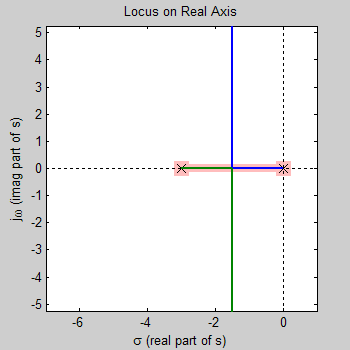
The root locus exists on real axis to left of an odd number of poles and zeros of open loop transfer function, G(s)H(s), that are on the real axis. These real pole and zero locations are highlighted on diagram, along with the portion of the locus that exists on the real axis.
Root locus exists on real axis between:
0 and -3
... because on the
real axis, we have 2 poles at s = -3, 0, and we have no zeros.
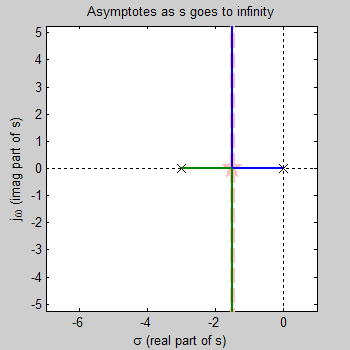
In the open loop transfer function, G(s)H(s), we have n=2 finite poles, and
m=0 finite zeros, therefore we have q=n-m=2 zeros at infinity.
Angle of
asymptotes at odd multiples of ±180°/q, (i.e., ±90°)
There exists 2 poles
at s = 0, -3, ...so sum of poles=-3.
There exists 0 zeros, ...so sum of
zeros=0.
(Any imaginary components of poles and zeros cancel when summed
because they appear as complex conjugate pairs.)
Intersect of asymptotes
is at ((sum of poles)-(sum of zeros))/q = -1.5.
Intersect is at ((-3)-(0))/2
= -3/2 = -1.5 (highlighted by five pointed star).
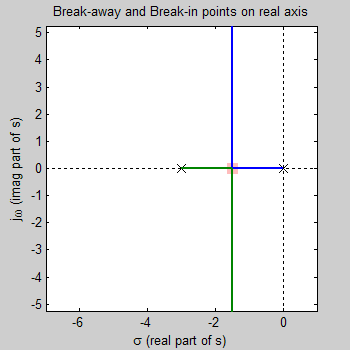
Break Out (or Break In) points occur where N(s)D'(s)-N'(s)D(s)=0, or 2 s + 3
= 0. (details below*)
This polynomial has 1 root at s = -1.5.
From these 1 root, there exists 1 real root at s = -1.5. These are
highlighted on the diagram above (with squares or diamonds.)
These roots
are all on the locus (i.e., K>0), and are highlighted with squares.
*
N(s) and D(s) are numerator and denominator polynomials of G(s)H(s), and the
tick mark, ', denotes differentiation.
N(s) = 1
N'(s) = 0
D(s)= s2
+ 3 s
D'(s)= 2 s + 3
N(s)D'(s)= 2 s + 3
N'(s)D(s)= 0
N(s)D'(s)-N'(s)D(s)= 2 s + 3
Here we used N(s)D'(s)-N'(s)D(s)=0, but we could multiply by -1 and use
N'(s)D(s)-N(s)D'(s)=0.
No complex poles in loop gain, so no angles of departure.
No complex zeros in loop gain, so no angles of arrival.
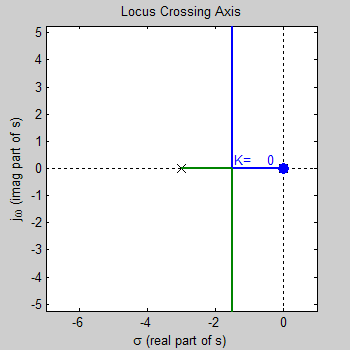
Locus crosses imaginary axis at 1 value of K. These values are normally
determined by using Routh's method. This program does it numerically, and
so is only an estimate.
Locus crosses where K = 0, corresponding to
crossing imaginary axis at s=0.
These crossings are shown on plot.
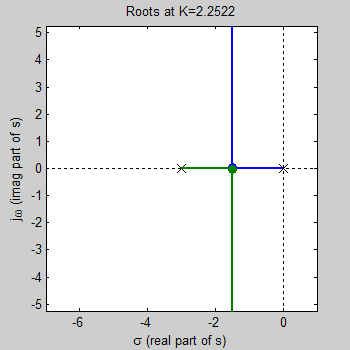
Characteristic Equation is 1+KG(s)H(s)=0, or 1+KN(s)/D(s)=0,
or D(s)+KN(s)
= s2 + 3 s+ K( 1 ) = 0
So, by choosing K we determine the
characteristic equation whose roots are the closed loop poles.
For
example with K=2.25225, then the characteristic equation is
D(s)+KN(s) = s2
+ 3 s + 2.2522( 1 ) = 0, or
s2 + 3 s + 2.2522= 0
This
equation has 2 roots at s = -1.5 ±0.047j. These are shown by the large
dots on the root locus plot
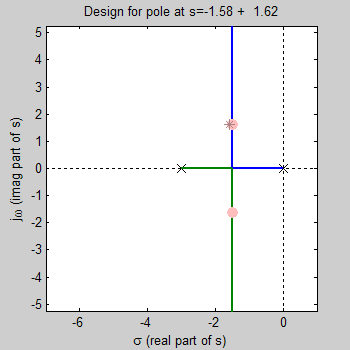
Characteristic Equation is 1+KG(s)H(s)=0, or 1+KN(s)/D(s)=0, or
K =
-D(s)/N(s) = -( s2 + 3 s ) / ( 1 )
We can pick a value of s on the
locus, and find K=-D(s)/N(s).
For example if we choose s= -1.6 + 1.6j
(marked by asterisk),
then D(s)=-4.87 + -0.243j, N(s)= 1 + 0j,
and K=-D(s)/N(s)= 4.87 + 0.243j.
This s value is not exactly on the locus, so K is complex, (see note below),
pick real part of K ( 4.87)
For this K there exist 2 closed loop poles at
s = -1.5 ± 1.6j. These poles are highlighted on the diagram with dots, the
value of "s" that was originally specified is shown by an asterisk.
Note:
it is often difficult to choose a value of s that is precisely on the locus, but
we can pick a point that is close. If the value is not exactly on the
locus, then the calculated value of K will be complex instead of real. Just
ignore the the imaginary part of K (which will be small).
Note also that only one pole location was chosen and this determines the value of K. If the system has more than one closed loop pole, the location of the other poles are determine solely by K, and may be in undesirable locations.